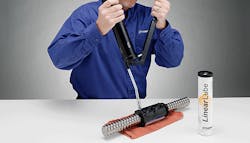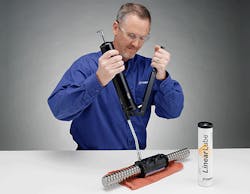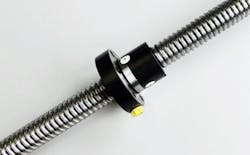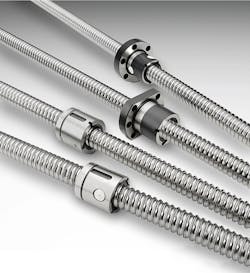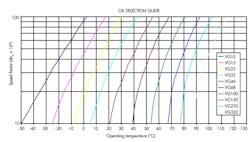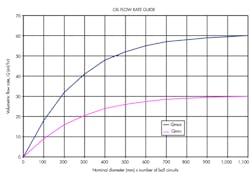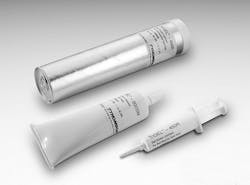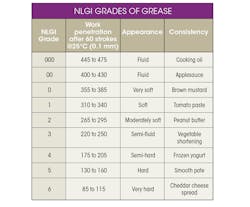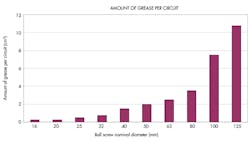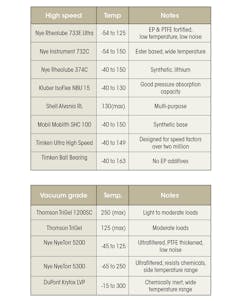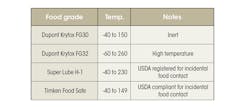Selecting a Lubricant for Ball Screws
This file type includes high-resolution graphics and schematics when applicable.
Lubricants on ball screws are as important to their performance and life as are their operating loads, speeds, accuracies, environments, and power requirements. Lubricant reduces the already low friction by minimizing contact between the balls and grooves, thus adding torque and increasing efficiency, while extending the screw’s life by a factor of 10. Proper selection and application of lubricants also affects contamination, a leading cause of premature ball-screw failure.
One of the first choices engineers must make is whether to use oil or grease.
Oil or Grease
The right choice of oil or grease for ball screws reduces unscheduled downtime and repairs by ensuring the assemblies deliver their expected service lives. Pumps and metering devices deliver oil; grease gets applied through fittings on the ball nut or attachment flange. The main application differences are in flow control, risk of contamination, and cost.
It is easier to direct oil exactly to where it is needed. It will also clean out moisture and other contaminants as it runs through the ball nut and provide cooling. On the downside, oil requires an investment in pumps and meters, and excess oil can introduce contaminants, for example, by mixing with the cutting fluid in a machine.
Grease gets applied directly to the screw’s threads near the root of the ball track or pumped directly into the ball nut if there are lube holes. Grease fittings contain lubrication and repel contamination. They also cost less and are cleaner than oil pumps and meters. But grease is hard to keep inside the ball nut and tends to accumulate at the ends of ball-nut travel, where it attracts chips and abrasive particles.
Excess grease must be removed, leaving only a thin lubricating film on the screw shaft. Wipers may be needed to keep the grease inside the ball nut, but it is crucial to re-lubricate the assembly with grease at least every 600 to 800 hr for most applications. Incompatibility of old grease with re-lubrication grease could become another problem.
Both oil and grease fittings can be equipped with filters if precise motion and smooth, quiet operations are needed. Filtration also improves the homogeneity of the thickening agent and removes virtually all particulate matter.
Lubrication methods are designed at the manufacturer, so it is important to understand the tradeoffs before specifying a vendor product.
Selecting the Right Oil
Viscosity and application rate are key variables in selecting oil lubricants and they vary with temperature, load, and speed. The oil lubrication will influence the ball screw’s temperature rise and assembly’s life. Oil that is too viscous, or if there’s too much of it, raises operating temperature. Oil that is not viscous enough, or if there’s not enough of it, increases friction and wear.
The following guidelines apply to the most common temperature, load, or speed conditions.
To determine the appropriate viscosity at 40°C, for example, consider the mean speed of the ball screw, its diameter, and the temperature at which the ball nut is likely to stabilize. In the graph above, it shows how different grades of oil vary in viscosity across different temperatures. Viscosities are shown in centistokes (1 cSt = 1mm²/sec), and grades are designated according to their viscosity at a given temperature.
So, for example, the VG32 curve on the graph shows how oil with a 32-centistoke viscosity at 40°C would heat up as the speed increases. The dnm factor is the product of ball-screw diameter in mm and screw mean rotary speed in rpm.
To determine the oil’s nominal viscosity for an application, an engineer must first establish the ball screw’s mean rotational speed, and then the dnm factor. It is also necessary to factor in the temperature at which the ball nut will likely stabilize.
Mean speed of rotation accounts for the ball screw’s duty cycle:
nm = n1(q1/100) + n2(q2/100) + n3(q3/100) + …
where nm = mean speed (rpm); n1,2,3… = speed for time q1,2,3…, (rpm); and q1,2,3… = time at speed n1,2,3…, (% of total)
For typical applications, nm ranges from 200 to 500 rpm. The dnm factor is given by:
dnm = (d)(nm)
where d = ball-screw nominal diameter (mm).
Typical values of dnm range from 5,000 to 25,000. Values of dn up to 160,000, where n is the maximum speed of rotation, are becoming more common. In such cases, the lower viscosity oil should be used ora grade midway between two adjacent viscosity curves, such as VG32 and VG46.
The ball-nut temperature should be about 20°C when it is operating, but this is seldom the case. Usually, ball nuts stabilize a few degrees above the screw shaft’s operating temperature. If you can’t measure nut temperature, assume it is 30°C for the initial selection of oil viscosity.
The required oil flow rate is a function of the number of ball circuits, ball-screw orientation, load, speed, operating environment, and judgments based on knowledge of the application.
The oil flow rate guide (above) helps determine oil flow rate. Engineers multiply the balls screw’s nominal diameter times the number of ball circuits, then find the maximum and minimum flow rates, Qmax and Qmin, respectively, from the values on the Qmax and Qmin curves. For example, for a ball nut with six circuits and a 25-mm nominal diameter, the product, 150 mm, corresponds to a flow rate ranging from a minimum (Qmin) of 13 mL/hr to a maximum (Qmax) of 26 mL/hr.
The actual rate you should select within this range, however, depends on operating condition:
• If the ball screw is vertical, add 25% to Qmin to account for orientation; if horizontal, add nothing.
• If the application is dirty and wet, add 25% to Qmin; if not, add nothing.
• If the screw is subject to high loads or speeds, add 50% to Qmin; if it is not, add nothing.
For example, a 25-mm-diameter ball screw with six-circuit ball nut is used in a vertical application (add 25% to the minimum of 13 ml/hr); it is clean and dry (add 0%); and it is heavily loaded (add another 50%):
Qrequired = 13 + (13 * 0.25) + (13 * 0) + (13 * 0.50) = 22.75 mL/hr
Because it is best to supply small amounts of oil at regular intervals, and there will be heavy loads in this example, apply oil about every minute:
(22.75[mL/hr])(1/60[hr/min]) = 0.38[mL/min]
Without the heavy load, application every five minutes would be adequate.
A slightly thinner oil than indicated could be used with no problems. However, if the application calls for a VG46 oil, but a VG10 is all that can be used, revise the oil delivery by replacing spot delivery with continuous flow of the lighter oil.
Selecting the Right Grease
Selecting the proper grease is a bit more complex than oil specification. Greases consist of mineral or synthetic oil, additives, and thickening agents such as lithium, bentonite, aluminum, and barium complexes. Some issues to consider are synthetic versus mineral-based, additives, and environmental conditions. Note that speed is not a criterion for grease selection because, unlike oil, it can handle dn values as high as 1,000,000, which is about 10 times higher than dn’s typically found in ball screws.
Synthetic vs. mineral based: Synthetic greases offer performance advantages over mineral-based lubricants. They function over wider temperature ranges, offer greater stability, and retain the viscosity needed for adequate film thickness through a range of operating temperatures, speeds, and loads.
Additives: Special additives improve the ability to resist contaminants and reduce wear in the presence of load and vibration. Other additives reduce friction, decrease noise, and increase load capacity. Avoid greases with graphite or molybdenum disulfide, though, because they reduce friction to the point where it promotes ball skid and interferes with the ball bearings’ rolling process.
Specialty products: Specialty greases, including vacuum and food grade, as well as those for clean rooms or extreme temperatures, should be selected based on performance requirements.
To help engineers sort through the options, the National Lubricating Grease Institute (NLGI) identifies nine grades based on consistency (above). Although the list is not enough to specify which type of grease is right for a particular application, it does provide a useful qualitative measure.
The lower grades are softer and flow better. Higher numbers are firmer, tend to stay in place, and are a good choice when leaks are a concern. Grades 000 to 1 would typically be used in applications requiring low viscous friction. Grades 0, 1, and 2 are used in highly loaded gearing, and grades 1 through 4 are often used in rolling contact bearings, with Grade 2 being the most commonly used in that range.
The chart above gives recommendations on how much grease per circuit to use based on the ball screw’s nominal diameter. A 25-mm-diameter screw with six circuits, for example, requires 0.4 cm3/circuit, or 2.4 cm3 total.
The table below matches some of the leading grease brands to applications based on the NLGI guidelines and information published by grease or ball-screw manufacturers. While by no means a complete list, it should provide some useful guidance.
The decision to lubricate with oil or grease can critically affect ball-screw performance, durability, and the total cost of owning and operating it. Running without lubrication is just not an option.
In some cases the final decision is dictated by other key specifications, but wherever possible, designers of ball-screw applications should consider lubricant options as an important factor in decisions to specify one vendor product over another. And once the decision to go oil or grease is made, other choices must be made.
Oil lubricants tend to be easier to control, run cleaner, and are better at flushing out contaminants, but they can also require more costly pumping and metering support, and often introduce contaminants into the system. After oil is chosen, the challenge is to select the proper viscosity for the application, which can be calculated from the temperature, load, and speed by applying a standard equation.
Grease tends to be less expensive, has better heat resistance, and has a wider range of consistency, which can help effectively accomplish your lubrication goals. Grease is cleaner in terms of having fewer contaminants, but it also tends to pick up additional contamination as excess oozes from the nut. And, as with oil, once the choice is made, the next decision is selecting the right type of grease for the application. The NLGI (above) provides some guidelines to map grease consistency to applications.
Because options may vary with the vendors, especially for specialty applications, it is always a good idea to get complete specifications from them. It is also important to remember that proper maintenance is critical to performance.
This article was authored by Jeff Johnson, Global Product Line Manager, Screws, Randy Hamper Sr., Design Engineer, and Kelvin Kellond of Thomson Industries Inc., Wood Dale, Ill.
Looking for parts? Go to SourceESB.
